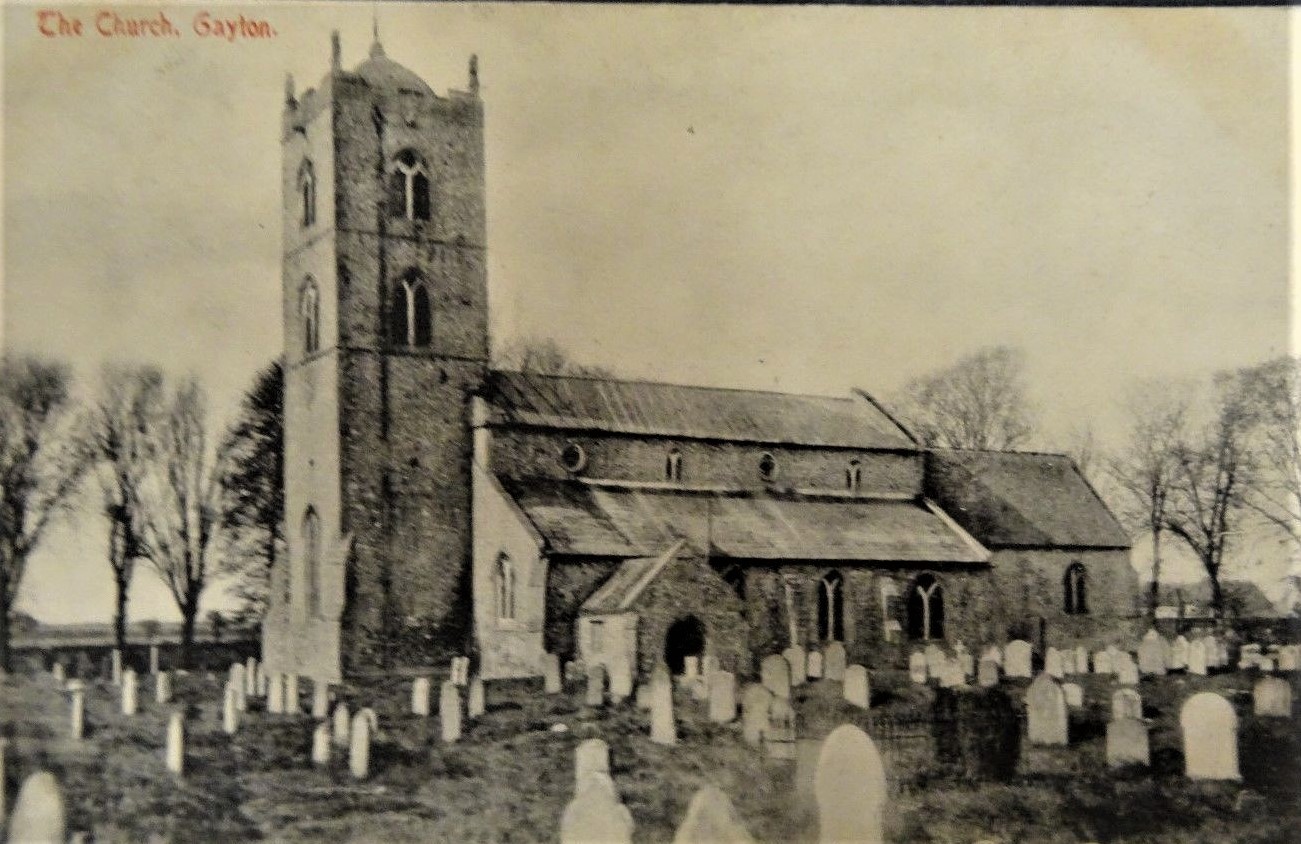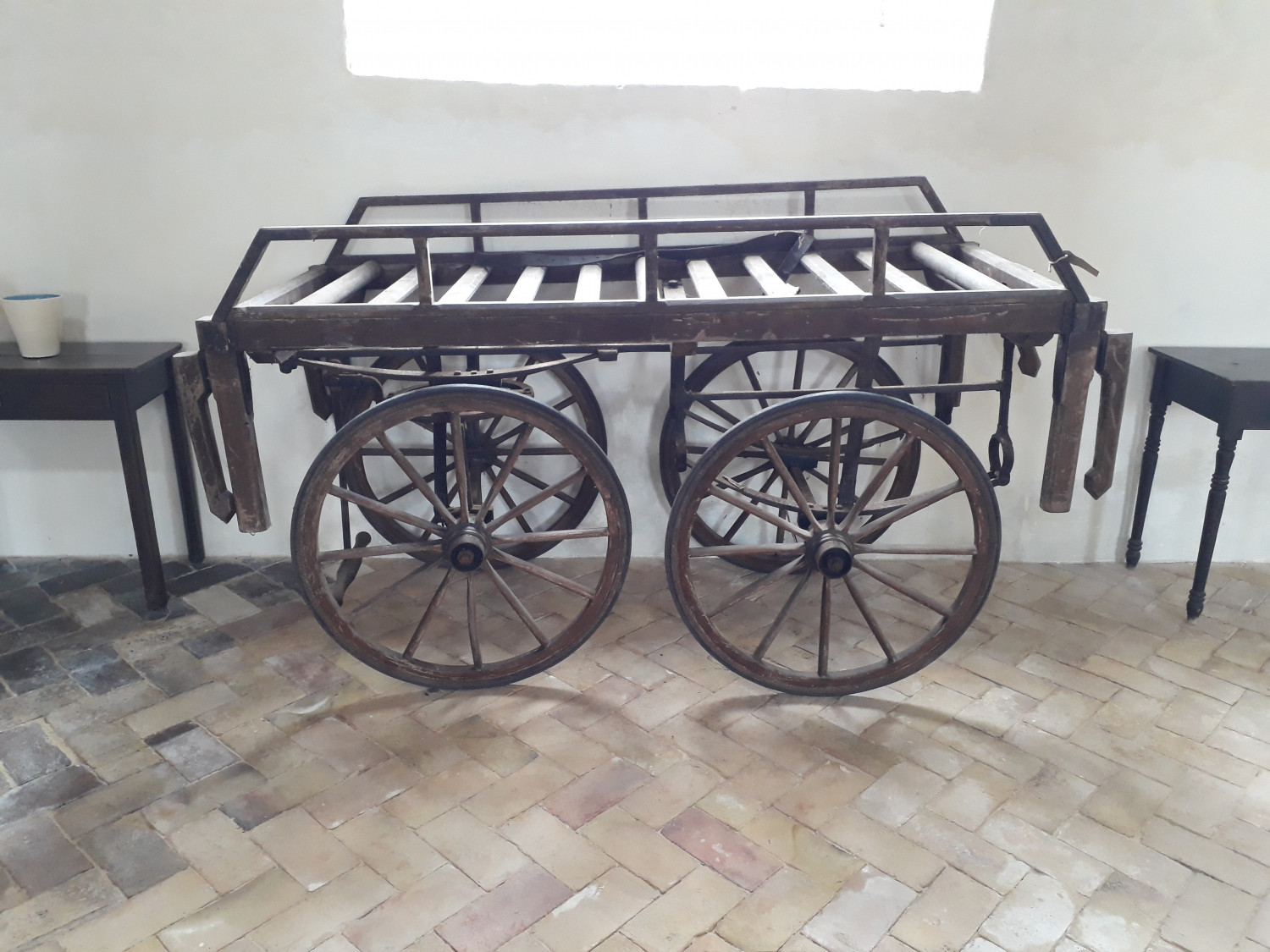 Approaching the church from Lynn Road you pass through the lychgate, the War Memorial to the twenty men of Gayton who died in the Great War, and a further three who gave their lives in the Second World War. It is usual for War Memorials to take the form of a stone obelisk or cross and it is rare to find one such as ours.
Approaching the church from Lynn Road you pass through the lychgate, the War Memorial to the twenty men of Gayton who died in the Great War, and a further three who gave their lives in the Second World War. It is usual for War Memorials to take the form of a stone obelisk or cross and it is rare to find one such as ours.

St Nicholas's Church, Gayton. Robert Ladbrooke c1831.
An old post card view of the Church
The date of the foundation of the church is not known, but according to the Rev. Charles Parkin (1689 – 1765), Rector of Oxborough, a Norfolk Historian of note, Hugh was Rector of Gayton during the reign of King Henry III (1216 – 1272). It is probable that the present church post-dates that time as the style of architecture is mainly“Decorated” rather than “Early English” and relates to the early 14th Century.The outside walls are made with natural flints set in lime mortar.
The Tower is remarkable for being so high without buttresses and for its unusual Dome  and four Evangelists rather than the more usual pinnacles.
and four Evangelists rather than the more usual pinnacles.
The unusual domed top to the tower is a special feature of Gayton church tower which shows well from the roads approaching the village. On the four corners are the emblems of the evangelists, now much weathered. They are the winged man for St Matthew, a lion for St Mark, an ox for St Luke and an eagle for St John.

|

|
 |
 |
The Church is predominately 14th century although there is evidence of earlier fabric from the simple "Y" tracery of the West tower window and silence chamber windows.
The porch dates from the 15th century and has an interesting stone dial on the South gable with a square headed hood mould.
On the east face of the tower can be seen the line of a former roof of the nave, which was thatched. The present roof is much later and may be contemporary with the heightening of the North and South clerestory walls that have a series of round and arched topped windows which throw light onto the nave. There is also evidence of a blocked opening in the East nave gable from the inside.
Lower down, inside the nave, yet another roof line is to be found, one that matches a much lower tower to which the buttresses belong. Clearly the extra belfry was added to the tower when the church was enlarged with aisles and clerestory.
The lower belfry openings are simple Y tracery typical of around 1300 whilst the upper belfry has openings of the distinctive Decorated Period 1320 – 1350.Two bells survive from an original five, one dated 1623, the other 1663. The nave pews were installed in 1849 and those in the south aisle a little earlier. In 1842,Alexander Simpson donated the east and west windows and in 1852, the clock, which is in good working order to this day.
Inside unusually the chancel arch is not wider and higher than those which form the bays. The aisle pillars have shafts of unusual height and neither western or eastern arch is in the centre of its gabled wall. They are those of a smaller Church ( during re-modelling in 2021, evidence of a wall was found below ground by the north east pillar) to which the north and south aisles were added some 500 years ago. When this was done the nave was extended 16.5 incehes southward.
There was formally a vestry to the north of the chancel of which the doorway and the foundation remains.
At the east end of the south aisle is a small piscine which may once have served a chapel and below the centre windoiw in the south aisle a possible aumbray which may well have served an earlier chaple before the south aisle was extended.
In 1849/50 the Church was "re-seated" ( the installation of new pews) and the timbers of the roof over the first bay, westward, replaced and the lead of taht part repaired and the whole roof with the slating over the north and south aisles made "wind and water tight" at a cost of £166.4s 1d.
In 2021, these pews were removed and in 2011 a great deal of work done on the roof - 170 years on. ( see the Church renovation page for more click here.)
Most of the windows have plain glass but the East Chancel window is Victorian, given by Alexander Simson, dated 1852. Thecquatrefoil window in the north aisle shows the Agnus Dei and was given in 1850.
The font dates from the 14th century.
In 1866, an organ was given by the Revd C T Jex Blake, the then vicar though this was replaced in 1985 by an organ from Norwich which is still over 100 years old.
In 1875, the three decker pulpit, probaly in use from the 17th century was reduced or converted into something "more seemly". the present pulpit was erected in 1893 by subscription as a "memorial to teh Revd W Aubrey-Cutting MA and Theresa Anne, his wife, both of whom died in 1892".
In 1878, a handsome oak communion table was the offering of Matilda St John.
In the East wall of the nave, above the Church arch, there were (in 1899) faint traces of a mural painting. More recently during restoration work in 2011, traces of a medieval wall painting were uncovered.
The reredos ( wall panelling behind the communion tabe) was carved by Belgian refugees when they were living in Ashwicken during the 1914-18 war. An oak from the park at Gayton Hall was given by the then Earl Romney for this.
The clock in the tower was supplied by Thomas Pung of King's Lynn ( born in Roydon) who also supplied the clock at Gt Massingahm. It was presented to Gayton by Alexander Simson Esq.
It is an early flat bed clock with a fine George Graham dead beat escapement whichb was invented in 1715. The striking part of the clock was removed at the start of the Second World War ( there was a ban on Church bell ringing during hostilities. This old part of the mechanism has disappeared but maybe they are stored unrecognised in a barn, shed or attic. It would be wonderful if vthey were found to be enable the chime to be restored.
Finally , we have in Church still the bier that was used to transport coffins. The story goes that all the villagers donated to purchase this other than one man - who, of course, was the first one to be carried on it !
, we have in Church still the bier that was used to transport coffins. The story goes that all the villagers donated to purchase this other than one man - who, of course, was the first one to be carried on it !
Nicholas Church at Gayton has stood at the centre of the village since the 13th century and is very much a part of village life. It is currently seeing a revival as, thanks to help from the Heritage Lottery Fund,the church building has been renovated in 2011 and again in 2021 and is now well on the way to be a place for the community. Read more here.
